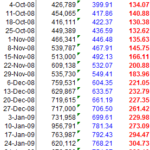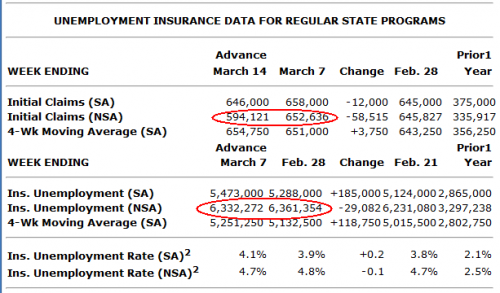Has the increase in U.S. jobless claims peaked?
Yesterday, the U.S. Department of Labor released its Unemployment Insurance Weekly Claims Report. I see the data as mostly good. The headline seasonally-adjusted numbers were 646,000 initial claims and 5.47 million continuing claims, both of which are extremely high – 5.47 million is a record. However, the real story is in the unadjusted numbers end of seasonal factors. And, this is becoming a better story every week.
Rewind a few months to November and December. In the United States, the holiday season is hugely important to retailers, making up a disproportionate amount of sales and income. This particular holiday season was a abysmal due to the credit crunch and severe economic weakness. However, how bad things were was not readily apparent in the data because of heavy seasonal adjustments due to the holiday season retail hiring cycle starting in late November (see the Jan. 8 post, “Jobless claims fall again due to seasonality.”
 As a result, unemployment numbers initially understated the magnitude of job losses. On a few occasions, I have noted that in the past year the increase in jobless claims has been much greater on an unadjusted basis than using the reported seasonal numbers (see post here). Therefore, we have seen a massive surge in the unemployment rate, as the seasonal numbers played catch up. In my view, this has caught out many policy-makers, the Obama Administration included.
As a result, unemployment numbers initially understated the magnitude of job losses. On a few occasions, I have noted that in the past year the increase in jobless claims has been much greater on an unadjusted basis than using the reported seasonal numbers (see post here). Therefore, we have seen a massive surge in the unemployment rate, as the seasonal numbers played catch up. In my view, this has caught out many policy-makers, the Obama Administration included.
This catch-up is now mostly complete. To be sure, the unemployment numbers will still rise quickly – more than still anticipated. However, in the next few months, I do not anticipate that it will rise as quickly as it has done. For example, if one looks at the actual claims data, the comparisons to last year are now peaking. In fact, this past week’s data was much better than the headline numbers would have you believe. Both initial claims and continuing claims fell.
The long and short here is two-fold. First, the unemployment rate still reflects an ‘under-count’ which I foresee bringing us quickly to 9% unemployment. This will be a negative shock. However, if year-over-year comparisons plateau for another month, this would make 3 months where we have stalled at an increase of roughly 300,000 weekly claims. The actual data now being released suggests a plateauing in the unemployment levels rate of change. To my mind, this could mean that the economy’s decline has seen its most violent period. If so, economic decline in the U.S. will continue but will be less severe in the summer and beyond.
Source
Unemployment Insurance Weekly Claims Report – U.S. Department of Labor

Thank you for this article. I have been tracking the weekly changes since the beginning of the year and have focused on the NSA numbers.
I agree with you that NSA unemployment should stabilize in the next 1-3 months, but I see that as a function of seasonality: Summer employment and graduate of high school and college getting jobs circa June. If it doesn’t stabilize, that would be an omen that the economy is still falling rather substantially.
Aside from stability in June, the next question is whether NSA unemployment spikes again in the autumn as those summer employees are laid off. I dunno, but I’m not yet optimistic.
Terry,
Interesting read on the seasonality of things. I would agree that seasonal factors would make it harder to pin things down in the summer. That’s why I think the reprieve we could have by then won’t necessarily last when September rolls around.
As for optimism, I’m in a wait and see mode as well. The data are not clear as to where we’re headed and much depends on the policy response, doesn’t it?
Cheers.
Edward